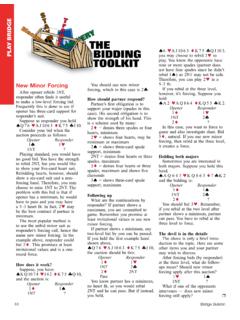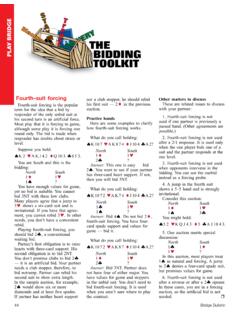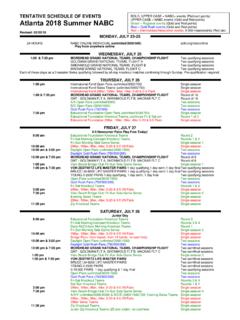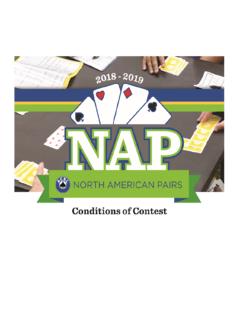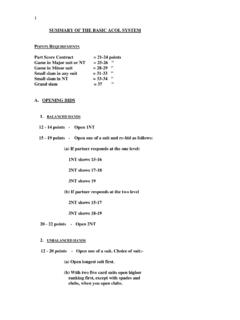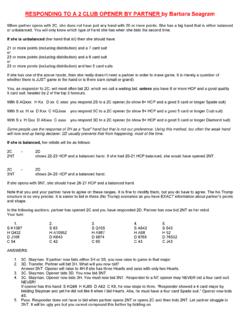Transcription of Commonly Used Conventions - Your Best Partner in …
1 1 Commonly used ConventionsBergen RaisesThis is a scheme of major-suit raises designed to get the partnership quickly to the three level or higher whenever there are nine or more combined trumps. It was developed by Marty Bergen, a well-known expert, based on Marty s experiences in partnership with Larry Cohen which also resulted in Larry s books on The Law of Total Tricks. The most common variation of Bergen raises in response to an opening bid of 1 or 1 is the following:Bergen Raises A raise of opener s suit to the two level shows 6 to 9 points and precisely three-card support. A raise of opener s suit to the three level is weak preemptive showing 0 to 6 points and four-card or longer support. A jump to 3 is artificial (conventional) and shows four-card or longer support with 7 to 10 points. A jump to 3 is artificial (conventional) and shows four-card or longer support with 11 or 12 points a limit raise.
2 A jump to the three level in the other major is artificial (con-ventional) and shows a game-forcing raise with shortness a singleton or a void in one of the side suits. Opener may ask where the shortness is by making the next cheapest bid. A jump to 3NT shows a balanced hand with precisely three-card support, game-going strength, and stoppers in all of the unbid suits. Opener may pass, bid the major suit to game, or look for example, consider the following hands for South after the auc-tion has started: WEST NORTH EAST SOUTH 1 Pass ?2 Commonly used ConventionsJump to 3 . A jump to 3 is a preemptive raise showing 0 to 6 points and four-card support. The idea is to make it difficult for the opponents to get into the auction. If North South can t make 3 , presumably the opponents can make at least a partscore, and per-haps a game to 3.
3 With 8 high-card points and four-card support for opener, South would make the artificial response of 3 . With a minimum hand, opener can rebid 3 . With a medium-strength hand, opener can jump to 4 .Jump to 3 . This shows four-card support and the strength for a limit raise. North can return to 3 to reject the invitation or jump to 4 to accept the invi-tation. This is similar to 1 3 when the Partner -ship plays limit raises opener passes or bids 4 .Jump to 3 . A jump to 3 , the other major suit, shows a forcing raise with shortness a singleton or a void in a side suit. Opener can simply rebid 4 with no interest in slam. With slam interest, opener makes the next cheapest bid, 3 , to ask about the shortness. South would now bid 4 to show the singleton, and North could evaluate the hand accordingly. K 9 7 4 A J 10 8 9 3 Q J 5 Q 9 7 3 A Q 8 3 K 8 6 4 2 Q J 8 4 A 8 9 6 3 J 8 7 4 K J 7 3 7 6 J 10 6 5 9 7 3 3 Commonly used ConventionsCappelletti (or Hamilton)This convention uses the following scheme over the opponent's 1NT: Double is for penalty.
4 2 shows a one-suited hand. 2 shows hearts and spades. 2 shows hearts and a minor suit. 2 shows spades and a minor example, suppose West holds the following hands after a 1NT opening bid by South when playing Cappelletti: a) 8 3 b) K Q 8 7 c) A J 9 8 5 K 7 5 A J 10 8 5 8 6 A Q J 9 8 3 10 9 3 K Q 8 7 3 9 2 5 7 With the first hand, West would bid 2 , showing a one-suited hand. East would be expected to bid 2 , unless holding a long club suit. West would now pass, to confirm diamonds as the suit. With the second hand, West would bid 2 , showing hearts and spades. With the third hand, West would bid 2 , showing spades and a mi-nor.
5 With no support for spades, East could bid 2NT, and West would now bid 3 .4 Commonly used ConventionsDONTDONT (Disturb Opponent s Notrump) was devised by Marty Bergen. Double shows a one-suited hand, usually not spades. 2 shows clubs and another suit. 2 shows diamonds and a major suit. 2 shows hearts and spades. 2 shows DONT, suppose West holds the following hands after South s opening bid of 1NT: a) 8 3 b) K Q 8 7 c) A J 9 8 5 K 7 5 A J 10 8 5 8 6 A Q J 9 8 3 10 9 3 K Q 8 7 3 9 2 5 7 With the first hand, West would double 1NT. East can bid 2 to play in West s suit and West would then bid 2 . With the second hand, West would bid 2 , showing hearts and spades.
6 With the third hand, West would bid 2 , showing diamonds and a major. With no support for diamonds, East could bid 2 , looking for West s major suit and West would then bid 2 .FlanneryConsider the following hand:Playing standard methods, this hand would be opened 1 . That could leave opener with a difficult choice of rebid if, for example, responder bids 1NT. With an unbalanced hand, opener doesn t want to pass and leave responder playing in 1NT, but any other option A Q 7 4 K 9 5 4 3 K 8 5 65 Commonly used Conventionscould get the partnership into more trouble. Opener s hearts are too weak to rebid. A rebid of 2 would be a reverse, forcing for one round (see Chapter 6), and since responder didn t bid 1 , it s unlikely the partnership has an eight-card fit in that suit. A rebid of 2 on a three-card suit is also unappetizing, although Partner could have length in that suit.
7 Opener would have a similar rebid problem if responder bid 2 , rather than avoid this predicament, William Flannery suggested using an opening bid of 2 , known as the Flannery 2 bid, to show 11 to 15 points with exactly four spades and five hearts. Responder then bids as follows: 2 or 2 is a sign-off in a major suit. 2NT is artificial (conventional) and forcing. It asks opener to further describe the hand as follows: 3 or 3 shows three cards in the suit. 3 shows a minimum (11 to 13) with two cards in each minor. 3 shows a maximum (14 or 15) with two cards in each minor. 3NT shows a maximum with a doubleton honor in both minors. 4 or 4 shows four cards in the suit (and a void in the other minor). 3 or 3 asks opener to bid 3NT with one of the top three honors in that suit.
8 3 or 3 is invitational in the major suit. 3NT, 4 , and 4 are sign-offs. 4 asks opener to bid 4 (transfer) and 4 asks opener to bid 4 (transfer).6 Commonly used ConventionsFor example, consider the following hands for responder after Partner opens with a Flannery 2 :Respond 2 . This is a sign-off bid in one of opener s suits. The partnership will be playing in an eight-card 4 (or 4 , or 2NT). The partnership should have a chance for a game contract playing in the nine-card fit. A response of 4 would be a trans-fer to 4 , allowing the contract to be played from Partner s side. Responder could also start with 2 NTto find out more about opener s hand although a slam is 2 is the most popular opening bid that shows a two-suited hand. It can be used if the partnership has another method of showing a strong opening bid in diamonds.
9 It s Commonly used in conjunction with weak two-bid openings in the majors 2 and 2 and an artificial strong 2 opening. It replaces the weak 2 opening bid. Four-suit TransfersA popular method for handling minor suits following an opening bid of 1NT is four-suit transfer bids. This is more complex than using 2 to sign off in either minor, but it has some advantages. The partnership will have to decide whether the advantages outweigh the additional complexity. Four-suit transfer bids work like this: A response of 2 is a transfer to 2 . A response of 2 is a transfer to 2 . A response of 2 is a transfer to 3 . A response of 2NT is a transfer to 3 . J 8 3 J 10 2 Q J 7 4 Q 8 7 K 10 8 3 2 Q 8 Q 9 3 A J 57 Commonly used ConventionsThe first two responses are the standard Jacoby transfers for the major suits. The 2 and 2NT responses are used to show the minor suits, either when responder wants to sign off in the minor suit or when responder is interested in bigger things.
10 These transfer bids give opener some latitude. With a minimum-strength hand and poor support for responder s minor, opener simply accepts the transfer. With extra strength and a good fit with the minor suit, opener makes the bid below the minor suit 2NT in reply to the 2 transfer bid, 3 in reply to the 2NT transfer bid. This allows responder to still stop at the three level in the minor suit with no interest in anything else, but encourages responder to bid more with a hand of at least invitational strength. For example: West WEST EAST East Q 9 5 4 1NT 2NT 8 3 A K 5 4 3 Pass 6 3 9 3 K Q 10 6 5 2 A Q 10 J 5 2 East bids 2NT as a transfer to diamonds.

